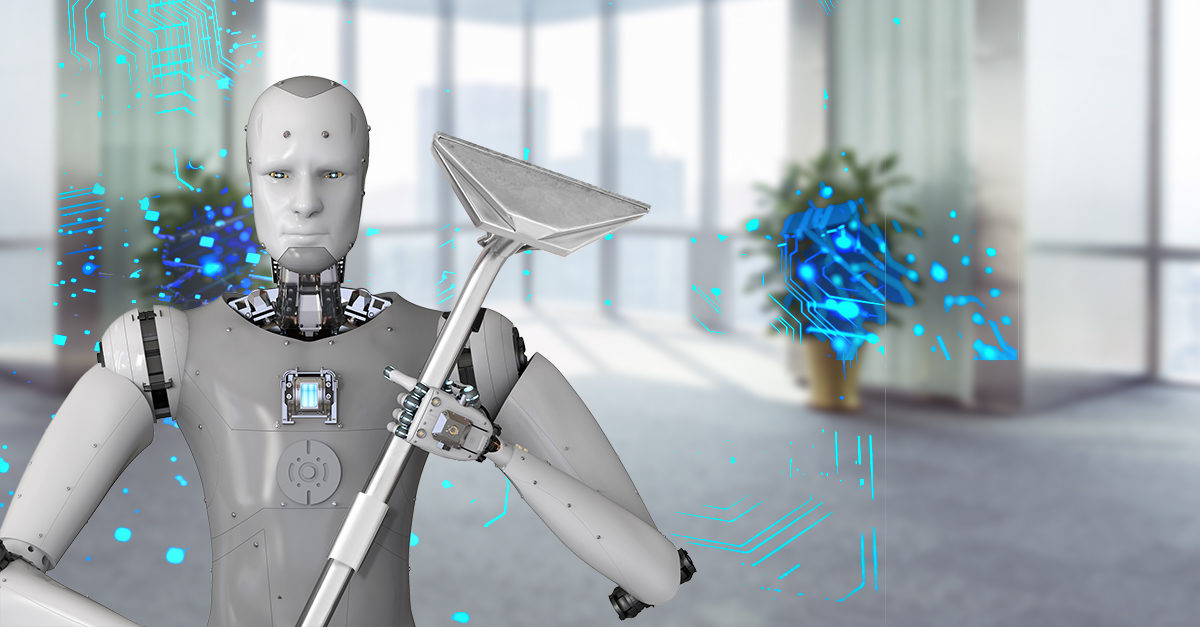The global cleaning industry is undergoing a revolution, with a convergence of automation and robotic technologies promising an increase in efficiency. Yet, the benefits to business from robotic cleaning lie less in the machinery and more in the intellectual property from the huge volumes of data they create.
While the recent pandemic was responsible for a short-term uptick in demand for robotic cleaning solutions, more entrenched global economics and industry competitiveness will drive long-term demand. In 2019, intelligence and analytics provider Beroe Inc. valued the global cleaning market at US$60.25 billion, with predictions of growth to $88.9 billion by 2025. This compound annual growth rate (CAGR) of 6.3% contrasts sharply with the predicted growth of an industry subset that is focused on innovative and technological cleaning solutions. Market analysts from Mordor Intelligence forecast the CAGR for the cleaning robot market as 23.3% between 2022 and 2027.
Industry pundits cite three specific reasons for the demand: increasing labor costs, safety concerns, and high customer turnover. Robotic cleaning can ease all three by reducing cleaning companies’ operational costs through labor reductions; using machinery to complete menial and ergonomically challenging tasks; and improving client satisfaction through improved cleaning speeds, consistency, and performance tracking.
While companies that fail to innovate with automation risk falling behind competitively, robotic cleaning is not a remedy for all the problems facing the cleaning industry. A commitment to automation requires detailed financial analysis and ongoing operational optimization. However, companies willing to make the commitment can enhance their competitiveness by selecting robotic cleaning machines with data-reporting capability. This technology offers operators nine areas where they can leverage data to improve efficiency.
1. Use data as convincing proof of service
As cleaning staff do a lot of their work after hours and unobserved by clients, it is not uncommon for clients to challenge contractors regarding whether they have cleaned an area or if they have claimed accurate working hours.
In the past, proof of service relied on staff and supervisor integrity and was open to client doubt and outright dismissal. Using machine-generated operating and performance data allows operators to capture and show performance for each cleaning operation and submit weekly service reports to the client.
These reports prove the contracted area was cleaned, providing date and time stamps as well as a breakdown of completed tasks. This automated reporting mitigates subjective disagreements and promotes the cleaning contractor’s brand by boosting the client’s perception of the company’s professionalism, competence, and sophistication.
2. Set contractual KPIs with objective data
A survey of almost 400 facilities in the United States conducted by Tennant Co. compared traditional measures of cleaning standards against data-driven standards. The results showed that data-driven fleets achieved 23% greater productivity and a 20% higher ranking for cleanliness and appearance. Clients also scored the data-driven fleets higher on customer satisfaction due to their efficient and effective cleaning.
Cleaning contractors find key performance indicators (KPIs) useful for determining critical items to focus on while measuring compliance with safety, quality, efficiency, and effectiveness metrics. It would be difficult to find cleaning service contracts today that do not contain KPIs for measuring contractor performance against minimum criteria to decide on contract renewal or remuneration decisions.
The data collected from robotic cleaners provides objective proof of the time spent on each task, the extent of the area cleaned, and the methodologies used. It also allows contractors to provide clients with proactive solutions and service optimizations that either reduce costs or increase efficiency.
3. Utilize robot performance data for maintenance strategies
In this new world of highly optimized cleaning routes using automated equipment, a cleaning contractor must focus on preventing machine downtime. Data-tracking software allows users to ascertain whether a breakdown has occurred, the machine has become obstructed, or someone is interfering with the equipment. Additionally, external maintenance contractors can receive and review machine performance, hours, and cycles and refine maintenance strategies accordingly using computerized maintenance management systems (CMMS).
These systems can alert the operators when scheduled maintenance is required and provide notice of a deterioration in equipment performance. If a defect is detected, virtual troubleshooting and even remote repair can prevent delays resulting from dispatching a technician to the site.
4. Take advantage of historical data for accurate quotes
Quoting on new jobs is an imperfect science that can result in lost revenue opportunities or commit cleaning firms to contracts with slim to no margin. As robotic cleaners amass in-service experience, the collected data becomes important intellectual property for a cleaning company.
By utilizing a schedule of capability for varying facility layouts and sizes, which can be constantly updated and refined to give accurate data for tight quotes, cleaning companies can ensure they will achieve their chosen margins and remain both financially viable and competitive.
5. Optimize cleaning routes
Operators of robotic cleaners are increasingly using artificial intelligence (AI) and machine learning to interrogate their collected data to calculate the most efficient methods for cleaning a familiar environment. Known as the path planning of coverage region (PPCR), the analytics engine accounts for the trajectory length, obstructions, and the number of turns.
Researchers continue to conduct significant investigations into this optimization. However, real-time data and optimized routes using machine learning have significantly improved cleaning times compared to a robotic cleaner solely using template patterns, according to research published in the Journal of Innovation in Digital Ecosystems. AI and PPCR technology offer cleaning companies a distinct competitive advantage, freeing up capacity for equipment reassignment, improved KPI compliance, reduced fleet sizing, and increased revenue-producing contracts.
6. Optimize staff workflow plans
Fleet tracking technology provides data on robot run-time, cleaned routes, and start-and-stop times. Combining this data with staff workflow planning allows users to optimize and appoint
cleaners to perform specialized cleaning tasks, augmenting or complimenting the robotic duties.
Spending time with staff to analyze robotic runtime data with the needs of each area provides an incremental improvement in efficiency and productivity through more efficient work flow
planning.
7. Revise your fleet size
Underused expensive assets reduce your operating profit and tie up important capital, making your business less competitive than your peers. Overutilized machines and cleaning personnel negatively affect machine reliability, reduce the lifespan of company assets, and harm the health and safety of your workers.
Robotic cleaner usage data can aid workflow by redeploying underutilized assets and identifying overutilized machines. Running the correct fleet size ensures efficient capital allocation while avoiding operational issues that increase cost and reduce effectiveness.
8. Leverage connected solutions
With the rise of the industrial internet of things (IIoT), many facilities are implementing networks to monitor room use, temperature, and air cleanliness. These networked facilities provide a platform to connect restrooms, towel and soap dispensers, robots, trash cans, and other smart devices, enabling them to work together to increase cleaning efficiency.
When robots travel around a facility, they can act as data collectors, providing information on which trash cans require emptying, which dispensers need refilling, and which rooms cleaning staff can ignore due to lack of use.
9. Improve OEM design and fleet statistics
For manufacturers of robotic cleaning equipment, access to historical in-service data provides crucial intelligence for devising equipment modifications, additional cleaning features, and software enhancements.
It also allows an original equipment manufacturer (OEM) to publish fleet statistics to assist users in understanding where their operation sits in comparison to their peers, highlighting average mean-time-between-failures (MTBF), component lives, and fleet mileage. Like the airlines, if OEMs see problems in robotic modules, they can make sure targeted service bulletins and product recalls are sent to users at similar cycle or mileage figures where the problem occurred.
While the context of each contract will influence equipment performance, understanding what other operators are experiencing assists business owners in making tactical and strategic decisions to optimize their asset allocation, capital expenditure, and operational costs.
Don’t be left behind
The cleaning industry has always been characterized by aggressive competition and razor-thin margins. With new technology applied to cleaning solutions, innovative cleaning companies are racing to embrace the benefits of robotic cleaners.
Unfortunately, many companies will be left behind as robotic cleaning becomes the new normal, with operators failing to realize the opportunities offered by data analysis, artificial intelligence, and machine learning.
In the coming years, businesses who choose automated cleaning solutions will gain advantages among the competition. Their leverage of the data generated by this technology will lead to optimized capital and costs, improved client satisfaction, and increased margin and revenue.




